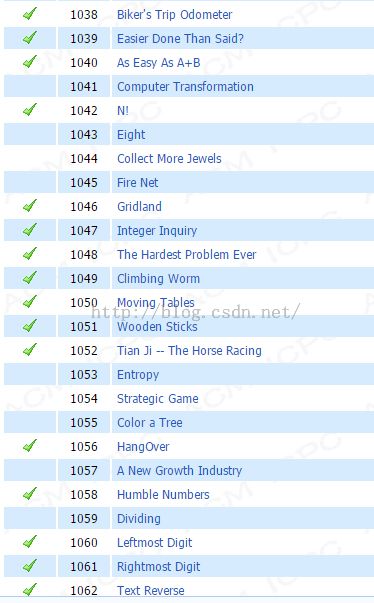HDU 1060.Leftmost Digit【重点在分析】【格式【晕】】【8月31】【记录】
Leftmost Digit
Problem Description
Given a positive integer N, you should output the leftmost digit of N^N.
Input
The input contains several test cases. The first line of the input is a single integer T which is the number of test cases. T test cases follow.
Each test case contains a single positive integer N(1<=N<=1,000,000,000).
Each test case contains a single positive integer N(1<=N<=1,000,000,000).
Output
For each test case, you should output the leftmost digit of N^N.
Sample Input
2 3 4
Sample Output
2 2HintIn the first case, 3 * 3 * 3 = 27, so the leftmost digit is 2. In the second case, 4 * 4 * 4 * 4 = 256, so the leftmost digit is 2.
题目大意是输入N,求N^N的最高位数字。1<=N<=1,000,000,000
估计大家看到N的范围就没想法了。
确实N的数字太大,如果想算出结果,即使不溢出也会超时。
题目是这样转化的。
首先用科学计数法来表示 N^N = a*10^x;
比如N = 3; 3^3 = 2.7 * 10^1;
我们要求的最右边的数字就是(int)a,即a的整数部分;
OK, 然后两边同时取以10为底的对数 lg(N^N) = lg(a*10^x) ;
化简 N*lg(N) = lg(a) + x;
继续化 N*lg(N) - x = lg(a)
a = 10^(N*lg(N) - x);
现在就只有x是未知的了,如果能用n来表示x的话,这题就解出来了。
又因为,x是N^N的位数。比如 N^N = 1200 ==> x = 3;
实际上就是 x 就是lg(N^N) 向下取整数,表示为[lg(N^N)]
a = 10^(N*lg(N) - [lg(N^N)]);
然后(int)a 就是答案了。
#include<cstdio>
#include<cmath>
int main(){
long double x;
long long N,T,A;
scanf("%lld",&T);
while(T--){
scanf("%lld",&N);
x=N*log10(N+0.0);
x-=(long long)x;
A=pow((long long)10,x);
printf("%lld\n",A);
}
return 0;
}
伤脑筋的一道题!
记录一下:
